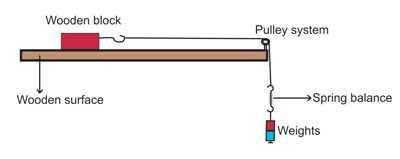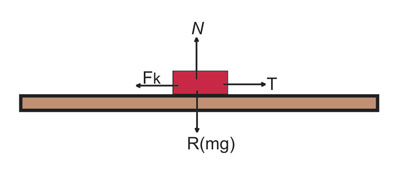|
The coefficient of kinetic friction between two surfaces
can be determined in the laboratory using the same experiment as that of kinetic
friction:

By the addition of the right weights that makes the block
to move at constant velocity, the net force acting on the body becomes zero.
Then, considering all forces acting on the block,
horizontally and vertically as shown below:

Resolving horizontal forces:
Kinetic frictional force, Fk minus the Tension on the
string equals zero. That is,
Fk – T = 0
Fk - T = 0
Fk = T
From the formula of kinetic friction, Fk
=
µk
N
Since Fk = T, then
T =
µk
N
Since the Tension on the string equals the attached
weights, Mg, then,
Mg =
µk
N --- equation 1
Resolving vertical forces:
Normal force N acting on the block minus weight of
the block mg equals zero. That is,
N – mg = 0
N = mg
Substituting mg for N in equation 1, we have,
Mg =
µk
mg
Therefore
µk
= Mg/mg
This means that the coefficient of kinetic friction
between the two surfaces is the ratio of the attached weights and the weight of
the block.
See
kinetic friction here
See static friction here
See
coefficient of static friction here
See
friction here
See
calculating friction here
|